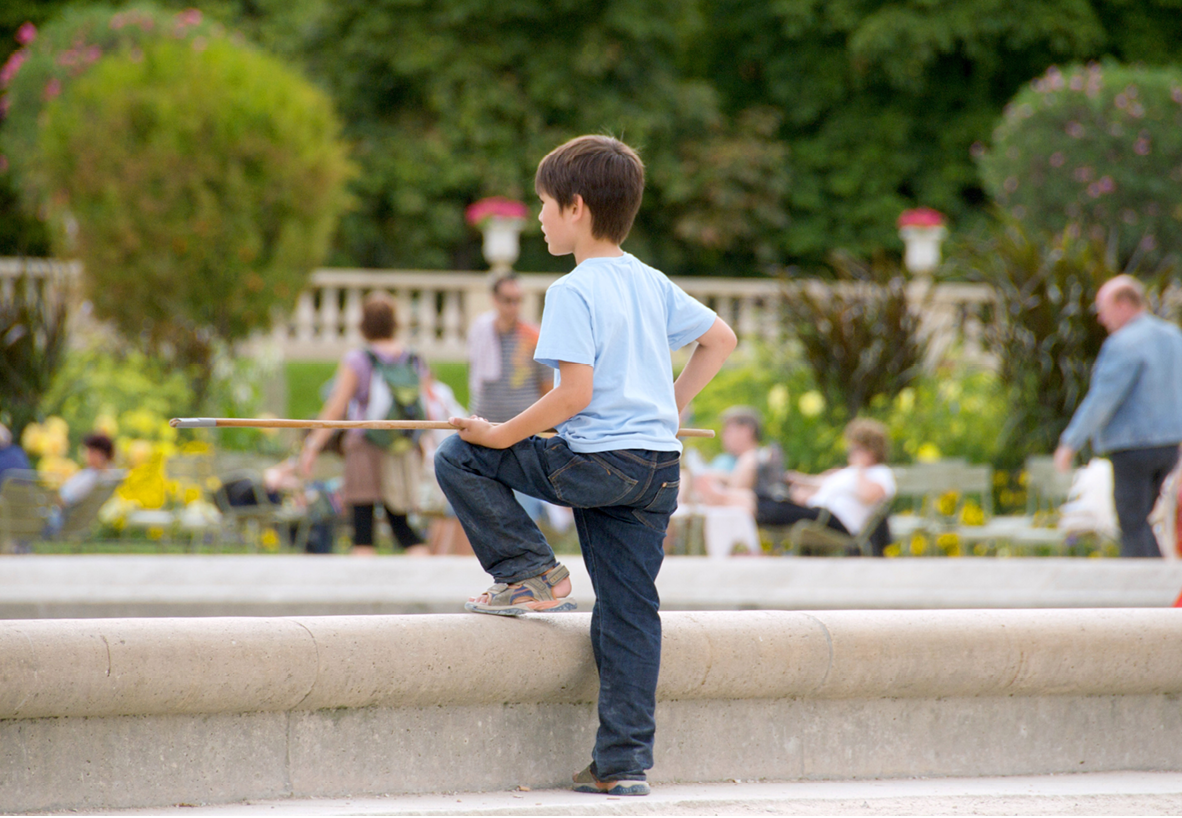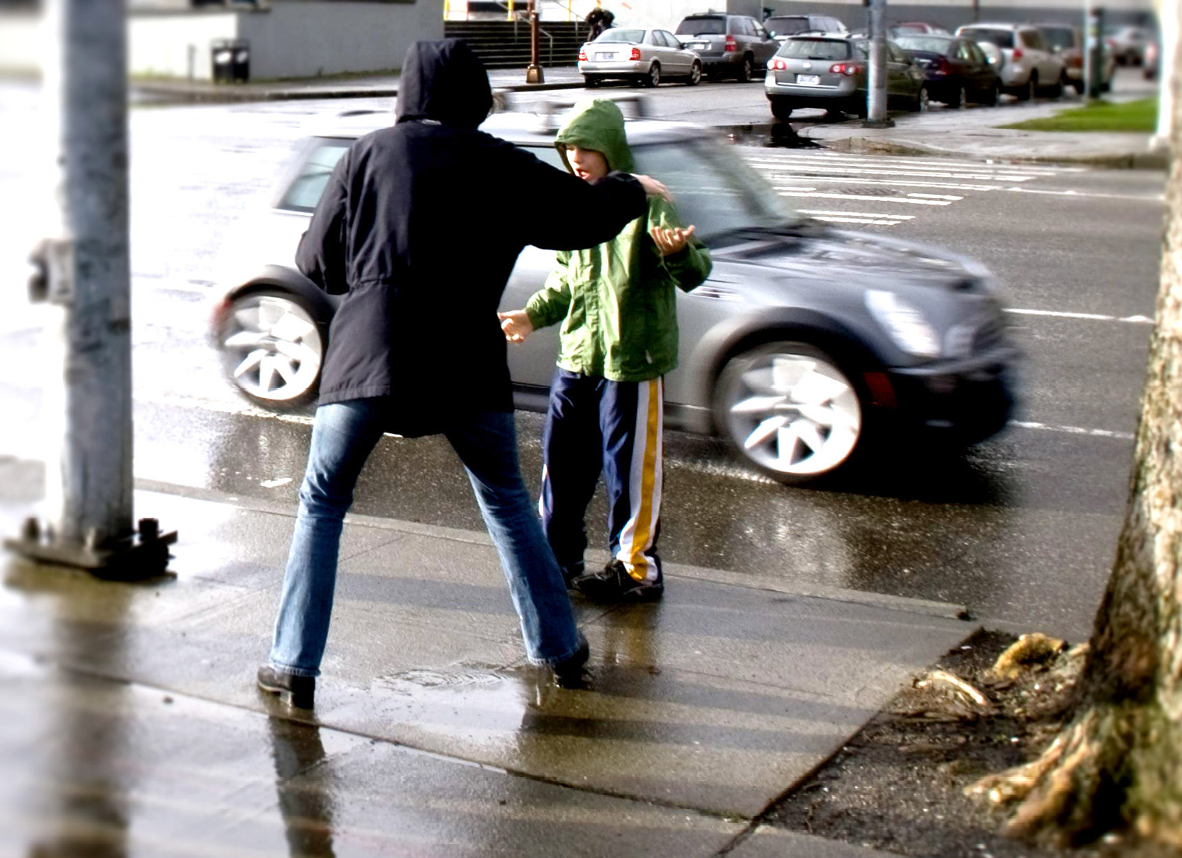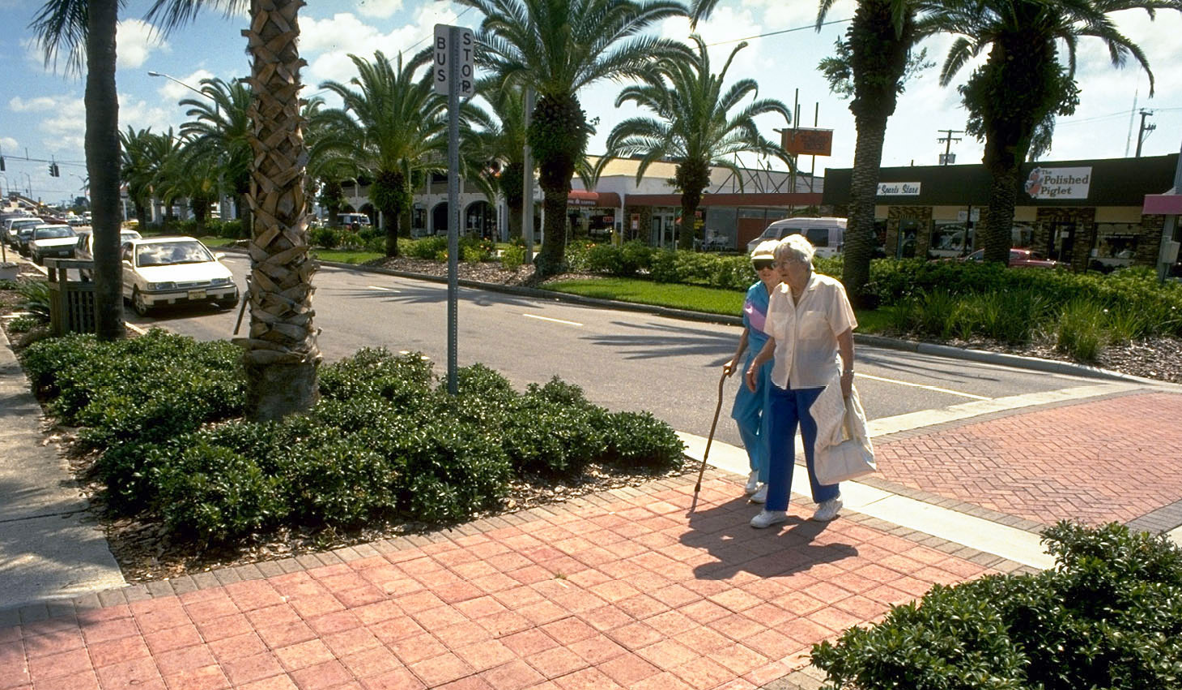Childhood Should Be about Exploring

Boy exploring creek (photo courtesy of Tom Woodward)
My wife Sharon and I often marvel at how highly scheduled and supervised the lives of our friends’ kids seem to be. Although we grew up in different circumstances, Sharon in a ranch house in a then-new suburb of DC and me in an apartment close to the downtown of a small North Carolina city, we both have fond memories of wandering, exploring, and following childhood whims in our neighborhoods. I could be wrong, but exploration seems rarer these days.
Instead, we have activities by appointment, almost all of which require car trips out of the immediate neighborhood and parental accompaniment. Say the phrase “soccer mom” and everyone knows what you mean: a mom who taxis her kids around to scheduled activities from the time they can walk, many of which do indeed involve soccer and most of which involve continued supervision. Some years ago a study by the Surface Transportation Policy Project found that a typical suburban mom spends the equivalent of 17 full days per year driving, more time than the average parent spends bathing or feeding a child.
There’s nothing wrong with soccer dates—soccer is “the beautiful game” and I’m a fan—but when do kids and their friends get to decide for themselves what to do and, within some reason, when and where? When do they get to learn that grownups also lead their own, independent lives? I have some very happy memories of tossing baseballs, basketballs, and especially footballs with my father; and I played the usual kids’ team sports. But, if my parents had been there for every practice and every game, as seems to be today’s norm, I would have gone absolutely batty. I would have been embarrassed.
I won’t pretend to understand all the reasons why parents today seem more reluctant to encourage their kids to explore on their own—surely they are complex—but here are a couple of ideas:
- Parents are afraid, especially of abduction or harm from strangers (though statistically these are no more common today than when I was a kid).
- Our culture of spread-out living and car dependence means fewer sidewalks, more car trips, more dangerous automobile traffic, perhaps weaker friend networks in neighborhoods, and less free time.
All this is implicit in a wonderfully written and provocative essay by Michael Chabon, published in The New York Review of Books in 2009. It is so good that I am tempted to reprint the whole of “Manhood for Amateurs: the Wilderness of Childhood,” but instead I’ll give you a taste:
“When you went out into those woods behind our house, you could feel all that history, those battles and dramas and romances, those stories. You could work it into your games, your imaginings, your lonely flights from the turmoil or torpor of your life at home. My friends and I spent hours there, braves, crusaders, commandos, blues and grays.
“But the Wilderness of Childhood, as any kid could attest who grew up, like my father, on the streets of Flatbush in the Forties, had nothing to do with trees or nature. I could lose myself on vacant lots and playgrounds, in the alleyway behind the Wawa, in the neighbors’ yards, on the sidewalks. Anywhere, in short, I could reach on my bicycle, a 1970 Schwinn Typhoon, Coke-can red with a banana seat, a sissy bar, and ape-hanger handlebars…
“Childhood is, or has been, or ought to be, the great original adventure, a tale of privation, courage, constant vigilance, danger, and sometimes calamity. For the most part the young adventurer sets forth equipped only with the fragmentary map—marked here and there by tigers and mean kids with air rifles—that he or she has been able to construct out of a patchwork of personal misfortune, bedtime reading, and the accumulated local lore of the neighborhood children.”

Boy in Jardin du Luxembourg (photo courtesy of Tom Ricker)
That’s the way it should be, Chabon argues, but not the way it is:
“I have been to Chicago maybe a half-dozen times in my life, on book tours, and yet I still don’t know my North Shore from my North Side, because every time I’ve visited, I have been picked up and driven around, and taken to see the sights by someone far more versed than I in the city’s wonders and hazards. State Street, Halsted Street, the Loop—to me it’s all a vast jumbled lot of stage sets and backdrops passing by the window of a car.
“This is the kind of door-to-door, all-encompassing escort service that we adults have contrived to provide for our children. We schedule their encounters for them, driving them to and from one another’s houses so they never get a chance to discover the unexplored lands between. If they are lucky, we send them out to play in the backyard, where they can be safely fenced in and even, in extreme cases, monitored with security cameras. When my family and I moved onto our street in Berkeley, the family next door included a nine-year-old girl; in the house two doors down the other way, there was a nine-year-old boy, her exact contemporary and, like her, a lifelong resident of the street. They had never met.”
I want to go on and on, but you should read it for yourself.
Two great bloggers found Chabon’s essay before I did, and made some thoughtful observations relevant to community planning. First, John Michlig, writing in his blog Sprawled Out: The Search for Community in the American Suburb, echoes Chabon’s thoughts and relates them to his own community of Franklin, Wisconsin:
“Another sad victim of suburban non-planning is the ability of our children to enjoy the freedom of wandering a ‘territory’ of their own. Our children now need to be escorted via car to pretty much every event in their lives. Even the occasional decently sidewalked subdivision is enclosed by wall-of-China collector roads that are impassible and limit safe travel.
“A few nights ago the local news featured the story of a child hit by a car in a nearby suburb. A neighbor pointed out the road it happened on; a typically winding, wide, pedal-to-the-metal subdivision speedway. The kid made the mistake of riding his bike a few hundred yards from his house in the hostile environment we currently embrace.
“There was talk of an ice cream shop going into Andy’s on Rawson and 51st (still planned, as far as I know). Sadly, it’s a horrible idea—who would let their child travel there independently, crossing 51st or Rawson? Yet, there it will likely stand, beckoning for—- cars. We will drive our children there, and they will have their ice cream under our sheltering eyes.”
Second, Sarah Goodyear, writing in Streetsblog, echoed that what is most stifling to kids’ freedom today is a preponderance of streets that are unsafe because of automobiles. Indeed, the Robert Woods Johnson Foundation has cited data indicating that kids who live near heavy traffic will have a five percent increase in Body Mass Index, on average, compared to those who don’t. The implication is that they are less likely to expend their energy walking outdoors, because it is perceived as unsafe.
In an earlier post Goodyear makes the point that, while parents fear to let their kids ride public transit independently (the city bus was a godsend when I was a kid) or walk a few blocks, they think nothing of driving them everywhere. But car crashes, she reports, are the leading cause of death for kids in the US.

Just in time (photo courtesy of pawpaw67/Ed L)
Now, the odds of dying in any one car trip are certainly low. But Goodyear goes on to quote Lenore Skenozy, the author of the provocative book Free-Range Kids. Skenozy says that, compared to the dangers of automobile travel, “the chances are 40 times slimmer that your kid walking to school, whether or not she’s the only one, is going to be hurt by a stranger.” And she would learn independence, an important life skill to acquire before one enters adulthood.
As I write this, I will soon be visiting my own mother, now in her ninety-third year. She’s in a different sort of wilderness now, a sad one, but I am so glad that she and my father had a few other things to do when I was growing up and allowed me to find my independence. Would I have become a tennis player if I hadn’t been able to find my way on foot to the courts a mile from home? Would I have become an environmentalist if I hadn’t explored the woods on my own? Would things have turned out differently if every activity had required a car trip? Those were the days.
More about Inter-Generational Community
The Elusive Goal of Aging in Place
Most aging adults want to remain in their own neighborhoods as their housing needs change and their comfort level with driving wanes. But few of our newer communities provide a variety of housing options so that a senior citizen could, perhaps, downsize from a single-family home to an apartment without leaving the neighborhood. Fewer still provide good transit service or shops and amenities within a safe and easy walking distance—critical for seniors who can no longer drive. For example, my mother’s home was at the end of a long driveway in a neighborhood without sidewalks. When it became difficult and eventually unsafe for her to drive, she found herself more and more isolated. This is all too common among seniors.

Safe crossings are critical for seniors (photo courtesy of www.pedbikeimages.org/Dan Burden)
Fredrick Kunkle summarized the unfortunate consequences in an article published in the Washington Post:
- Older nondrivers are likely to make 15 percent fewer trips to the doctor, 59 percent fewer trips to stores or restaurants, and 65 percent fewer trips to social, family, or religious gatherings.
- 3.6 million nondrivers older than 65 stay at home on any given day.
- Six hundred thousand people aged 70 and older stop driving every year.
- More than 20 percent of Americans 56 and older do not drive.
- The number of senior citizens is expected to double by 2030.
Some charities and informal groups are heroically pitching in to drive folks around. They deserve medals. But guess what: finding volunteers to do the driving is difficult because most of the people who are available during the day are retired and themselves elderly. Kunkle cited one case in which an 80-year-old drove a 60-year-old cancer patient to the doctor’s office; the scheduled driver for the follow-up trip was 87.
One of the answers to this problem—and maybe the most important one related to the built environment—is to build communities that contain a variety of housing types and prices, including facilities for seniors. Another is to build neighborhoods that are safe, convenient, and interesting for all, including nondrivers and people with special needs. Transit service is critical if people are to reach destinations beyond walking distance. But, for most cities and towns, these are long-term solutions.
What to do in the meantime? I wish I had better answers.